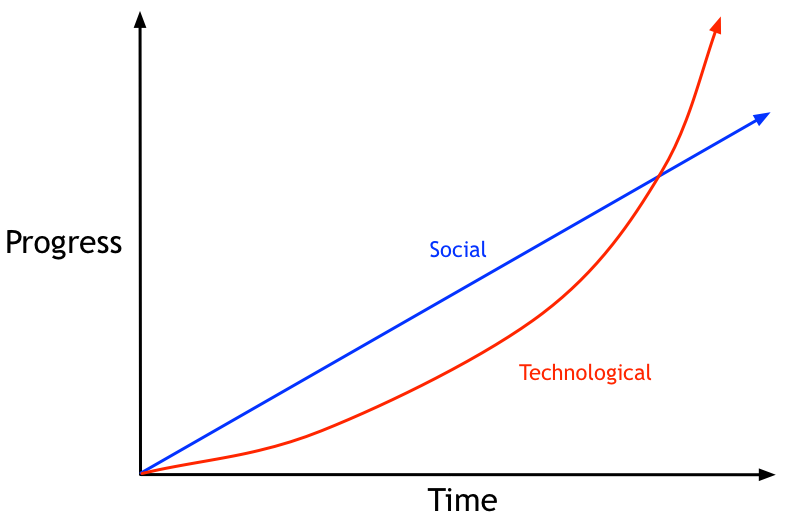The Fermi Paradox is easy to understand. There are a zillion planets out there. If the probability of a planet developing a society capable of interstellar travel is greater than one in a zillion, then there should have been at least one planet that did so, and it would have colonized the entire galaxy by this time, which means that we would be knee-deep in little green men. But alas, little green men are not being trampled underfoot. So the probability of a planet developing a society capable of interstellar travel seems to be extremely low — yet that capability seems to be plausibly within our reach in a few centuries. At least, that’s what Star Trek posits, and we all know that Star Trek is truth.
What gives? I think I have an answer. Let’s start with an observation about a certain class of growth. Here’s a photo of some tree rings from a tree I had to cut down:

Note that the rings are all approximately equal in thickness. But note also that the outer rings have more surface area than the inner rings, because they occupy larger circles. To put it in mathematical terms, if the thickness of each ring is t, and the diameter of the circle it forms is d, then the surface area of each ring is:
π*d*t
In other words, each year, the tree adds more wood than it did in the year before. The growth rate of the tree is proportional to its size, because a bigger tree has more leaves to collect sunlight and more roots to gather water.
Or consider the growth of bacteria on a petri dish:

The nutrients that feed the bacteria surround the colonies. A bigger colony is in contact with a larger amount of nutrient, so it grows faster. Lots of growing things show this principle: corals, mushrooms, even stalagmites:

The Analogy Jump
Here’s the big idea: the same principle applies to a society’s knowledge of technology. Every new discovery opens up more possibilities for discovery. For example, the discovery of magnetism opened the door to a host of other discoveries: electromagnetism, electric motors, inductors, relays, mass spectrometers, the nature of light, atomic physics, and on and on. The development of computers opened up a huge range of possibilities for further discovery, by using computers both to gather data, to compile data, and to analyze data. Thus, the rate of learning increases with the amount of knowledge already held. This also applies at the individual level. Learning how to read opened up the gigantic world of books to me, and my ability to learn expanded enormously. As I learned more, I began to see connections between disparate phenomena. The sky is blue for the same reason the sunset is red. The development of waterwheels sheds light on the progress of floppy disk drives. The early history of the cinema helps us understand the limitations of videogames. Speaking of videogames, one of the most far-reaching connections I made was when I used a trick from the Mayan mathematical system (which was really weird—they didn’t have multiplication or division) to solve a problem in designing a video game back in 1979.
“The more I learn, the less I know”
This might sound like it contradicts my thesis. But consider it using the petri dish analogy. As your knowledge grows larger, like a colony of bacteria on a petri dish, you come into contact with knowledge that was previously completely beyond your ken. How can you understand the significance of the Adages of Erasmus if you don’t even know who Erasmus was? You cannot possibly grasp calculus until after you’ve learned addition. Our knowledge builds on our existing base of knowledge like a colony of bacteria on a Petri dish, fed by even more knowledge that we become aware of.
Technological Progress
Let us return to the technological progress of any society. Buckminster Fuller estimated that human knowledge doubled about once per century right up until about 1900. By the middle of the 20th century, knowledge was doubling every 25 years. By the beginning of this century, knowledge was doubling every few years. A Google search will tell you that knowledge is now doubling every 13 hours. That’s nonsense. To store that much knowledge, in one year, we’d need 10**70 times as much storage capacity as we have now. Moreover, there’s a big difference between knowledge and information. The number of cat videos on the internet is increasing at a staggering rate, but the amount of actual new knowledge provided by all those cat videos is insignificant. To put it cruelly, if you’ve seen one cat video, you’ve seen ‘em all.
Despite this, there’s no question that our technological knowledge is doubling at an ever-faster rate. That’s good!
Social Progress
Technology can be used for good or for evil. Our ability to confine its use to beneficial purposes comes from our social institutions, which must be able to adapt to changing circumstances. Initially, genetic change was the only vehicle for adaptation to changing circumstances. Very roughly speaking, it takes about 10,000 generations for a species to implement genetic changes to adapt to a significant change in its environment — about a quarter of a million years in the case of hominens. However, hominems invented something vastly more flexible: culture, which permitted them to adapt to changing circumstances on a time scale of a dozen generations or so.
Culture, in the form of social mores, was adequate to address changes on a time scale of centuries to millenia. However, once civilization got started and population densities began rising rapidly, social mores weren’t up to the task of keeping groups larger than a few hundred working together smoothly, so societies developed larger social structures to cope with ever-faster change. Chiefdoms gave way to kingdoms which gave way to republics. See Francis Fukuyama’s book, The Origins of Political Order. We’re now working on developing international institutions that can cope with problems arising from the ever more intense interactions among nation-states.
But we’re falling further and further behind the pace of technological progress, because the human capacity for change is limited by fundamental constraints. Specifically, our fundamental moral values are fixed in our childhood; many people alive today were raised in the 1950s and 1960s when moral standards were different. Consider, for example, the social progress of women in our society. Women didn’t get the vote until just a hundred years ago. Fifty years ago we had the Women’s Lib movement in which women demanded complete equality, and most of us readily accepted that demand. Yet women are STILL being treated as lesser beings. Sexism definitely played a role in the defeat of Ms. Clinton in 2016. Women who accuse men of sexual assaults are STILL being regarded with suspicion; such accusations are given credence only when we get at least five or more women testifying against one man. It will take several more generations before our moral standards catch up with reality.
For example, nuclear physics opened up all sorts of wonderful technologies, but it has also made possible nuclear war, which would destroy civilization. Fortunately, our technological progress 70 years ago was so slow that we had enough time to develop appropriate checks on nuclear weapons (the ultimate success of those checks has yet to be determined). But what about the Internet? It has made our lives immeasurably better — but it has also permitted billions of dollars of cybercrime, and the Russians used the Internet to help Mr. Trump be elected as President. We still don’t understand all the possibilities for destruction created by the Internet. If somebody manages to shut down the Internet, the costs to society would be stupendous.
We’re building newer and more powerful technologies faster and faster, and yet our cultural and legal institutions are not adapting faster and faster. We don’t elect a new government at faster and faster rates. We don’t even understand the implications of new technologies at faster and faster rates. We don’t educate our citizens at faster and faster rates. We don’t modify our moral sensibilities at faster and faster rates. Everything about our adaptability is at best linear, because we’re still the same species that was living in caves a hundred thousand years ago. Technology is steadily outstripping our ability to confine its effects to the beneficial.
Let’s plot the accelerating pace of technological change against the adaptive capacity of human society:

We misuse the technology at some point shortly after the red line crosses the blue line. That’s when we die.
The accumulation of knowledge is demonstrably an accelerating process. The adaptation to new technology is historically a linear process limited by our evolutionary past. Therefore, the red line MUST cross the blue line. This is true of every single society in the history of the universe, because any species must start off with low-speed adaptive
This resolves the Fermi Paradox. We are not knee-deep in little green men because they always kill themselves off before they reach the ability to colonize other planetary systems.
